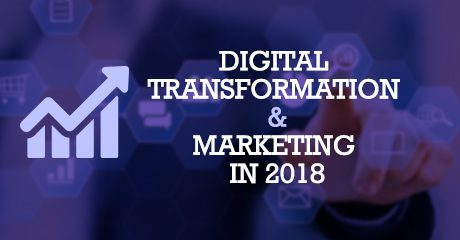Digital transformation and marketing: what does 2018 hold in store?
Marketeers, 2018 is counting on you!
The necessity of digital transformation is now taken for granted in a majority of firms. We’ve gone from the “why?” to the “how?”: how can a brand rely on digitalisation and technological change to develop its marketing strategy and take advantage of new growth opportunities?
Purchase behaviours as well as business models are shifting, and with these shifts we must rethink our marketing strategies, value chains, and processes. Above all, the pervasiveness of customer experience brings de facto the marketing department at the forefront of digital transformation.
This critical role of marketing is taking place in an environment of multiplying uncertainty factors (socio-cultural, economic, technological, legal or others). The fact that these uncertainties have become an integral part of the standard mode of operation of businesses is the first challenge for 2018. But it is by no means the only one:
- The strategic importance of customer insight and its corollary, data,
- The diffusion of technologies that were previously relatively private,
- The necessary adaptation of human resources,
- And finally, the adjustment of organisations to these new challenges.
However, while business digital transformation brings its share of new constraints, there are also tremendous opportunities opening to marketing in 2018.
Marketing strategy: the new reality of digital transformation
How can we, in 2018, develop a marketing strategy that capitalises on Business Intelligence, foresight, digital communication, but also on an innovative and effective traffic management, a decrypted and optimised customer journey, and on an actual omnichannel distribution?
2018 continues the digital transformation which has begun in 2017 and what lies ahead is, in broad terms, already known. However, digital transformation, first perceived as a transition, turns out to be a permanent and unstable state. The environment has gone from complicated to complex; it is increasingly uncertain. Organisations that will prevail are those that find a way to fit into this new paradigm.
Planification and process optimisation have long been the credo of successful companies. The height of this trend was lean management, production optimisation writ large. Digital transformation ended this willingness to plan, schedule, control, monitor all things, and lean management has now been replaced with Agile, Scrum, Kanban methods and the like, which incorporate uncertainty into the project and focus on individuals and interactions rather than on tools and processes. While the ultimate goal must remain clear to all, the road towards it may vary according to various factors.
Marketing: in 2018 more than ever, practice makes perfect
The recipe for marketing in 2018? Stop applying recipes, and most importantly, stop believing in those. Be flexible and innovating, stay in tune with the market and with your customers!
New business models continue to emerge and transform, or even disrupt, whole sectors. Technological innovation becomes accessible to all. Data asserts its crucial importance and omnichannel combines enrichment of customer experience and databases. A growth hacking approach (rapid trial-and-error) is now the key to the success of a strategy. As creator of the growth hacking concept, Sean Ellis, defines it as “a process of agile experimentation that aims at increasing the number of clients and the turnover. In it converge data analysis, user experience, marketing and products.” [own translation]
2018 will stay under the sign of customer insight and data
Customer experience (CX), including personalised offers and communications, will remain at the heart of global concerns in 2018.
Adrian Brown, a well-known customer service strategy consultant, explains: “Personalisation will be key to creating long-lasting relationships with guests. (…) One-size-fits-all is not a recipe for success in this increasingly digital world. Collecting customer data across their whole experience, really understanding their motivations and their desired outcomes for their stay is vital.”
The underlying trends remain and, at the same time, constraints are intensifying. The boom of mobile in recent years, the diversification of channels, the convergence of physical and digital, the evolution of data protection legislation, and the proliferation of touch points all make customer journey optimisation increasingly complex. For instance, although the mobile experience remains a priority for Google, it has become secondary compared to AI. As such, the advent of AMP – Accelerated Mobile Pages – may bring about more change in 2018.
The optimised customer journey, trivial much? Not really. For Amazon, one second of loading time would represent a loss of 1.6 billion dollars a year. A few tenths of seconds more to display Google results? With more than 8 million searches a day, this means as much loss in ad revenues.
Digital transformation and marketing: the technological challenges of 2018
Technological solutions adapt and multiply to respond to the customer experience optimisation challenge.
Leverage your data
The strategic value of data is getting stronger in 2018.
And with it, the development of new solutions for collecting, analysing, segmenting and activating data. It becomes imperative for brands to be able to leverage these solutions to feed their marketing strategy.
Speaking of the importance of data, the example of Carrefour is impressive: 54 employees are working on the 14 million holders of loyalty cards in order to better understand their consumption behaviour. All these data are processed by a big data system adapted to the processing of 3 million daily physical transactions.
Artificial Intelligence gains momentum
Artificial Intelligence (IA), previously marginalised and confined to science fiction, definitely stretches into the daily lives of consumers and enters the marketing concrete practices.
Last May, Google CEO Sundar Pichai, declared that the company would undergo “an important shift from a mobile first world to an AI first world.”
Intelligent personal assistants should very soon become the new essentials of household equipment. With a major challenge: becoming the leader of human-machine interaction. Amazon Echo, Google Assistant, and soon Apple’s HomePod, are already lining up.
AI is also the opportunity to better serve the consumer through an ever more personalised experience. Systems learn better and faster than humans, interact with each other, with visitors, or with connected objects. The point is to have an increasingly effective targeting, service, streamlining, and above all, therefore, sell better.
Thanks to customer insight, Netflix offers a personalised experience to each client with its subscription service for watching TV episodes and movies: recommendations are based on users’ movie taste and viewing history. Uber, Flixbus, as well as numerous digital box offices and airlines are already using dynamic pricing algorithms in order to set rates aligned with what the client is willing to pay. Direct Assurance’s DriveBox allows differentiated insurance rates based on road behaviour.
AI also allows marketeers to predict the future: proactive brands adapt in real time to consumer practices and behaviours in order to better anticipate. With ever more fluid shopping patterns as result, all channels alike. More conversions, less abandonment. A better pre-purchase targeting (acquisition) and a better follow-up (cross-selling).
Yet without data, no AI. Hence the need to develop a clear strategy integrating data marketing: a customized website, a consolidated CRM database, a mobile friendly or mobile first strategy, the adoption of new powerful solutions such as a DMP, RTB, programmatic advertising, chatbots…
Marketing and Human Resources challenges
Such a complex and unstable environment requires agile and creative human resources.
According to Gartner, by 2018, the number of manual workers will be cut in half, while digital-related employment will go up by 500%. This paradigm shift will revolutionise the way companies and employees operate.
New expertises and a more agile staff
The profession of Community Manager didn’t exist a few years ago, and according to Dell, 80% of jobs that will exist in 2030 haven’t been invented yet. In the same way it implies new modes of operation, digital transformation means new profiles and expertises:
- Flexible profiles able to integrate interdisciplinarity into their mode of operation and to build on each other’s knowledge. To view and think beyond marketing. To adopt a test and learn approach for each project: experience, optimise, measure, readapt. Profiles who are aware of the importance of continuous self-training, inclined to share their knowledge and able to absorb new concepts and trends.
- New specific expertises concerning, in particular, content creation, digital evolutions (social media, omnichannel presence), as well as data collection, analysis and reproduction.
In the face of new needs, HR are also on the lookout for new solutions
Digital recruitment and, more generally, digital sourcing, is likely to increase even more in 2018. For marketing, meeting new HR challenges is based on a choice between:
- Outsourcing and collaboration with freelance profiles. However, it is increasingly difficult to find resources outside the firm, with regard to the need for a growing number of sophisticated expertises. It constitutes a means of either cutting some costs, or benefiting from a proven expertise that’s too expensive or too rare to internalise (or both). This approach includes a certain level of risk of dependence, that will have to be appropriately managed.
- Insourcing or the internalisation of strategic skills to develop the company. French multinational company Safran prefers insourcing, with a whole team dedicated to advisory services: “Internal resources have several advantages: they are familiar with the group. There’s no adaptation time, there’s no need to explain the scale of the problem because they’re already in the group and in the culture, they know the operating rules… All of this saves us a lot of time.” (Thierry de Mazancourt, own translation).
Although the challenge is to find the right candidate and hence to attract often rare and sought-after profiles. HR marketing will therefore be a major component for 2018: employer brand, inbound HR, social recruiting…
Thus, BPCE, one of France’s largest banks, foresees the integration of 800 new digital profiles by 2020 and is already working on its employer brand. “These are skills [product owners, UX designers, data scientists, Editor’s note] that we are primarily seeking outside the company. A great deal of work is necessary to improve our employer brand because BPCE isn’t a commercial brand,” says Catherine Halberstadt, Director General of Human Resources [own translation].
Digital transformation: digital marketing experiences organisational and internal communication challenges
Today, while any brand claims to put customers at the heart of its modus operandi, this declaration of intent is still often a bit out of touch with a more nuanced reality. The across-the-board organisation required by a “customer-centric” culture still faces a vertical thinking (silo operating). Will 2018 finally bury these silos?
It’s still a long shot. According to a study conducted by the HR intelligence chair of IGS Group and backed by BDO, the proliferation of enterprise social networks (ESN) supposed to address the issue has been shown to strengthen it: instead of breaking silos, ESN tend to reproduce the actual hierarchical structure.
Marketing: a pivotal role’s expanded boundaries
Marketing, the leader of digital transformation, naturally sees its boundaries expand. It orchestrates the complete customer journey and creates necessary bridges between different departments.
- In this regard, we must make sure to coordinate the corporate functions that directly interact with clients and contribute to their experience with the brand: communication, billing, (after) sales…
- This presupposes a greater convergence of computer services and marketing, a consequence of the rise of omnichannel and big/smart data. Hence the implementation of an information system effective enough for the customer to experience fluidity, whatever communication channel they are using.
The effectiveness of these reconciliations will be essential to commercial success in 2018.
Necessary as it is, the aforementioned reconciliation is often far from operational. Many businesses face the phenomenon of Shadow IT: information technology projects that are managed outside of, and without the knowledge of, the IT department. With all the risks of failure this involves.
An evolving practice that internal communication must encourage and support
Internal communication is put at the centre of the digital transformation process as well, in relation to the human and cultural challenges associated with the current major organisational, managerial and technological evolutions.
The emergence and permanent development of innovating technologies promotes a shared vision and common values, as well as the adoption of new collaborative practices. Digital events, social gaming, enterprise social networks (ESN) raise new forms of management and collaboration. In 2018, internal communication will have to support this evolution.
Sylvain Hudelot, Global Community Manager of Plazza, Orange’s ESN, evokes the benefits from such technologies: “We save time and money by enhancing information within the structures and reaching out to the experts in real time in order to come up with the best answer for our customers.” [own translation]
Interested to know more? Subscribe to our newsletter – We will address these concerns in more detail in the course of 2018.










